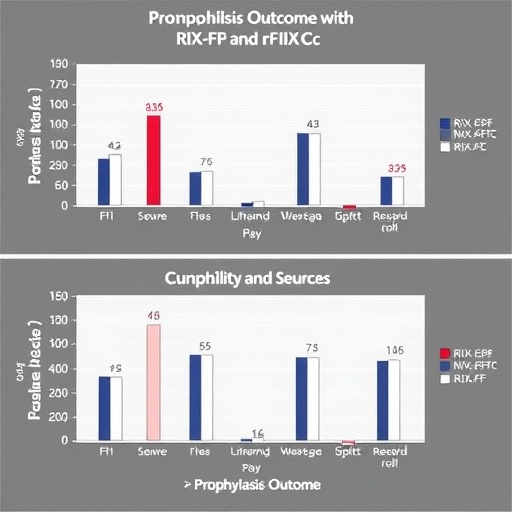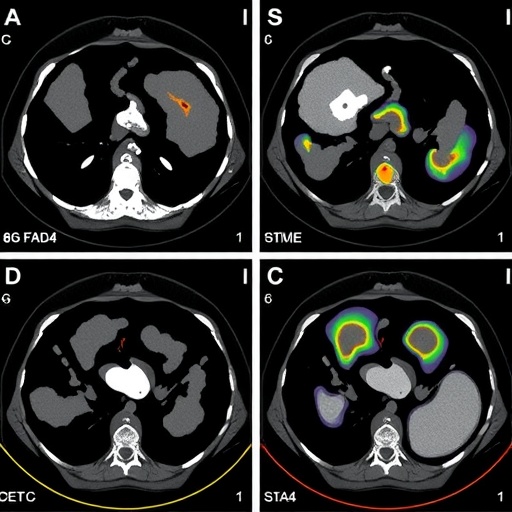PROTECT YOUR DNA WITH QUANTUM TECHNOLOGY
Orgo-Life the new way to the future Advertising by Adpathway
In a groundbreaking analysis published in “Advances in Therapy,” researchers detail significant findings regarding the outcomes of prophylaxis in hemophilia B management, particularly focusing on two innovative therapies: recombinant Factor IX-fusion protein (rIX-FP) and recombinant Factor IX Fc fusion protein (rFIXFc). This pooled analysis synthesizes medical chart data from diverse settings in Germany and Italy, presenting a clearer picture of how these therapies perform in real-world scenarios. The study conducts a comprehensive examination of treatment efficacy, safety, and patient quality of life, critical factors for patient-centered care in hemophilia management.
Hemophilia B is a hereditary bleeding disorder primarily affecting males, characterized by a deficiency of clotting factor IX. This deficiency leads to prolonged bleeding episodes, which can be spontaneous or injury-related, significantly impacting patients’ lives. Traditional factor replacement therapies have been effective, but new developments in recombinant therapies promise to enhance patient outcomes by improving efficacy and reducing infusion frequency. By comparing rIX-FP and rFIXFc, the study seeks to uncover insights that could redefine treatment paradigms for this challenging condition.
The analysis involved a meticulous review of patient records, creating a robust database that reflects both clinical efficacy and the real-life challenges faced by hemophilia patients. The diverse demographics of participants from both Germany and Italy allow for a comprehensive understanding of how different healthcare environments can affect treatment outcomes. The multidisciplinary team of researchers, including Oldenburg, Olivieri, and Yan, combined their expertise to evaluate a wide range of metrics, from bleeding episodes frequency to the psychological well-being of patients.
One of the primary objectives of this study was to assess the frequency of bleeding episodes among patients treated with rIX-FP and rFIXFc. Preliminary findings suggest that both therapies effectively reduce the incidence of bleeds compared to historical controls, with rFIXFc demonstrating a particularly favorable profile in patients requiring less frequent dosing. Such findings have profound implications for patient adherence and quality of life, as fewer infusions can substantially relieve the burden of treatment.
Moreover, the study delved into the safety profiles of each treatment. Patients receiving rFIXFc reported fewer adverse events related to their therapy—an encouraging outcome for clinicians striving to maximize therapeutic benefits while minimizing risks. The real-world data provides a critical validation of clinical trial results, reassuring patients and healthcare providers alike about the relative safety of these modern treatment options. This evidence-based approach is particularly crucial given the evolving landscape of hemophilia therapies.
Quality of life metrics were another focal point of the study, as optimal management of hemophilia is not solely about controlling bleeding episodes but also enhancing patients’ overall well-being. The researchers employed validated tools to capture data on physical health, emotional well-being, and social functioning. Results indicated that patients receiving prophylaxis with rIX-FP and rFIXFc reported significant improvements in their quality of life, underscoring the importance of integrating patient-reported outcomes in clinical evaluations.
With the increasing complexity of treatment options, healthcare providers are tasked with making informed choices tailored to individual patient profiles. This study’s findings equip clinicians with essential information regarding the real-world application of rIX-FP and rFIXFc. Providers can now weigh the benefits of reduced bleeding frequency and improved safety profiles against factors such as patient preference, convenience of dosing, and lifestyle considerations.
Additionally, the implications of this analysis extend beyond individual patient care. They inform healthcare policy and provide insights that can shape funding allocations for hemophilia care programs. As healthcare systems worldwide grapple with resource constraints, understanding the cost-effectiveness of different treatments becomes crucial. This study’s evidence could guide policymakers in making informed decisions that prioritize advanced therapies that deliver tangible benefits to patients.
Collaboration across borders is pivotal in advancing hemophilia care. By pooling data from Germany and Italy, the researchers successfully highlighted the collective experiences of patients within Europe. Such collaborations pave the way for more expansive studies that could include patients from various healthcare systems, offering an even richer dataset for analysis and enabling researchers to identify trends that could influence global treatment standards.
As we reflect on the insights gleaned from this pooled analysis, it becomes clear that the adoption of rIX-FP and rFIXFc is more than a mere evolution in treatment; it represents a shift towards more personalized medicine. The nuances of individual patient responses underscore the importance of ongoing research and flexible treatment regimens that can adapt to changing patient needs over time.
This research reinforces the importance of continuous monitoring and evaluation within clinical practice. As new therapies emerge and existing ones are re-evaluated, the need for robust real-world evidence becomes increasingly clear. This ongoing cycle of inquiry ensures that best practices evolve in concert with advancements in clinical research, ultimately enhancing patient outcomes in the realm of hemophilia B.
In summary, the research presented in this pooled analysis offers a comprehensive overview of real-world prophylaxis outcomes with rIX-FP and rFIXFc for males with hemophilia B. It highlights the effectiveness and safety of these novel therapies while emphasizing the critical importance of patient-reported outcomes in assessing treatment success. With the continued collaboration and dedication from the medical community, the future looks promising for individuals living with hemophilia B, as they stand on the verge of innovations that could significantly transform their treatment landscape.
As healthcare continues to advance, it is essential that both clinical and patient perspectives remain at the forefront of treatment discussions. This study provides a backbone for future research and paves the way for even more dynamic studies exploring the potential of other emerging therapies. By maintaining a focus on patient-centered care, we can hope to see even greater strides made in the management of hemophilia in the years to come.
Subject of Research: Prophylaxis outcomes with rIX-FP and rFIXFc for males with hemophilia B.
Article Title: Real-World Prophylaxis Outcomes with rIX-FP and rFIXFc for Males with Hemophilia B: Pooled Analysis of Medical Chart Data from Germany and Italy.
Article References:
Oldenburg, J., Olivieri, M., Yan, S. et al. Real-World Prophylaxis Outcomes with rIX-FP and rFIXFc for Males with Hemophilia B: Pooled Analysis of Medical Chart Data from Germany and Italy.
Adv Ther (2025). https://doi.org/10.1007/s12325-025-03303-7
Image Credits: AI Generated
DOI: 10.1007/s12325-025-03303-7
Keywords: Hemophilia B, rIX-FP, rFIXFc, prophylaxis outcomes, real-world data, quality of life, safety profiles, patient-centered care.
Tags: bleeding disorder treatment advancementsclinical efficacy of hemophilia treatmentshemophilia B clinical study findingshemophilia B managementpatient quality of life in hemophiliapatient-centered care in hemophiliaprophylaxis in hemophiliareal-world data in hemophilia treatmentrecombinant factor IX therapiesrFIXFc therapy efficacyrIX-FP therapy outcomestraditional versus modern hemophilia therapies


 3 hours ago
3
3 hours ago
3





















 English (US) ·
English (US) ·  French (CA) ·
French (CA) ·